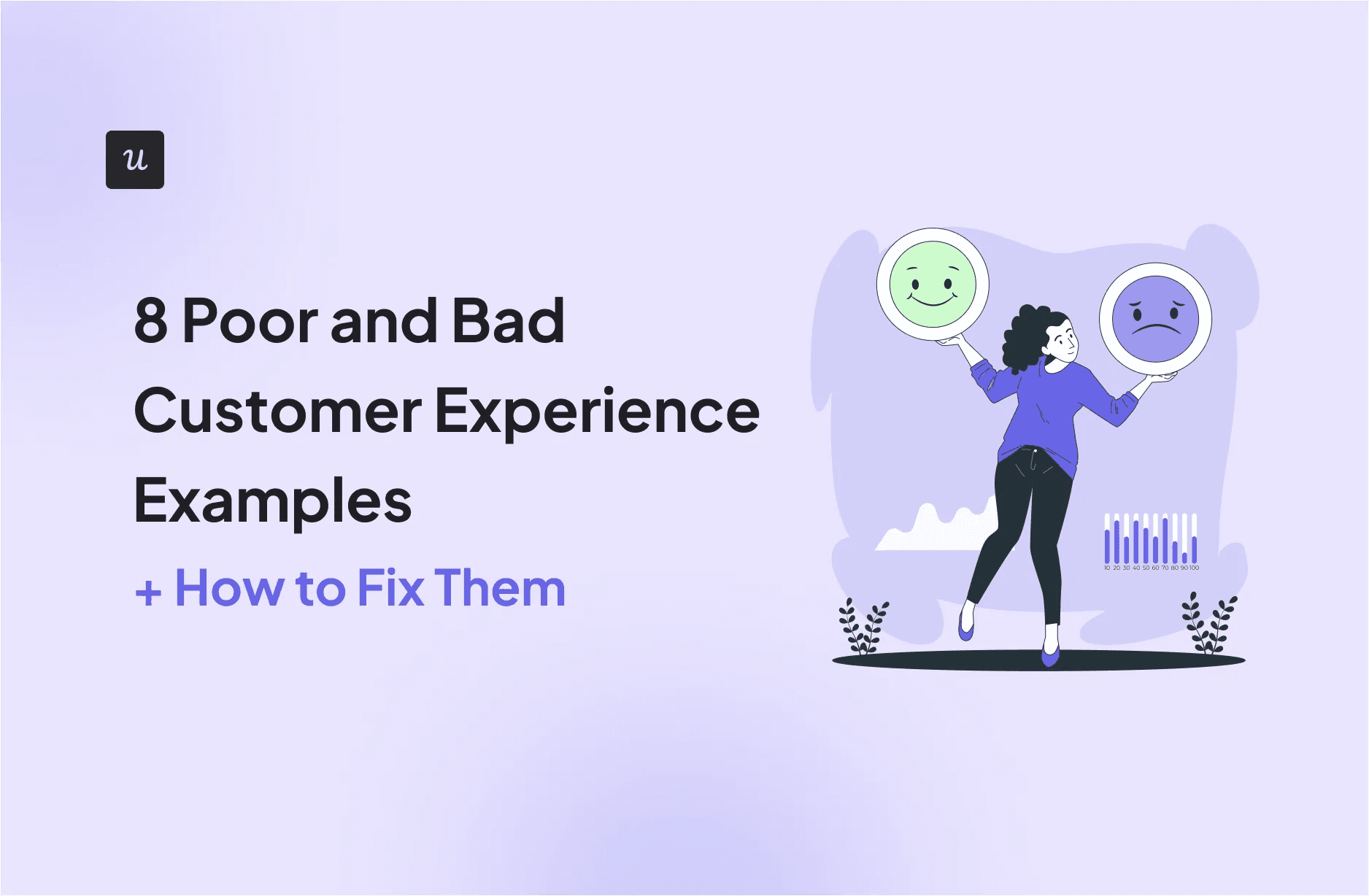
When a company fails to meet customer expectations, that’s called poor customer experience. Several elements feed into this experience, like customer service skills, quality, response time, and overall customer satisfaction.
In fact, according to Emplifi, 86% of customers are likely to abandon a brand they once trusted after just two negative experiences. The stakes are really that high – one wrong move means losing product engagement and retention for good.
The question then is, how do you always deliver good customer service? This article will help answer that while deep-diving into:
- Consequences of bad customer service.
- Examples of poor customer service.
- How to handle unhappy customers and other FAQs.
Try Userpilot Now
See Why 1,000+ Teams Choose Userpilot

Impacts of poor customer experience
- Customer churn: High rates of dissatisfaction lead to customers switching to competitors.
- Negative word of mouth: Unsatisfied customers are likely to share their negative experiences with others, harming brand reputation.
- Reduced revenue: Losing loyal customers because of poor service directly impacts sales and profitability.
- Diminished customer lifetime value: Similarly, poor experiences reduce the potential revenue from each customer over time.
- Increased costs: Bad experiences mean more issues for your company’s customer service department, which requires additional resources and time.
Examples of poor and bad customer experience
Let’s see some examples of poor customer experience which help highlight the critical areas you need to address to improve customer satisfaction and loyalty.
Lack of personalization
A pretty common example of bad customer service entails taking a one-size-fits-all approach. For instance, say you make new users answer multiple welcome survey questions. But when it comes to user onboarding, you continue showing generic messages and irrelevant features unrelated to their jobs-to-be-done (JTBD).
Imagine how impractical, not to mention annoying that must be!
Mailchimp does something similar, asking tons of questions upon sign-up, but none of that helps with customizing your in-app experience. Here are a few of those questions:
How to fix this?
- Create personalized onboarding modules for different customer types and segments.
- Leverage UI elements, like tooltips, modals, etc., to facilitate contextual engagement.
- Utilize relevant tools to automate targeting, like Userpilot.

Ineffective self-service options
Sometimes, customers run into issues that are small enough for them to troubleshoot on their own and continue their workflow with minimal disruption.
However, poor customer service strikes when you don’t provide customers with self-service support options to troubleshoot independently. This could be for several reasons, not limited to:
- Difficult self-service access, e.g. unorganized help center design.
- Limited help content formats.
- Inaccurate or not updated help resources.
How to fix this?
- Use a comprehensive self-service tool, like Userpilot.
- Incorporate multiple content formats, like videos or infographics.
- Leverage comprehensive analytics, like search term analytics, to see frequently searched phrases. Then identify what’s missing from your existing resources and make changes accordingly.

Difficult or confusing navigation
You’re trying to shop on a new website. But just locating the navigation menu takes a while because it’s on the right side instead of the left, where it commonly is. Even checking out is a challenge because the traditional cart or basket icon has been replaced by unfamiliar symbols.
All these changes, like inconsistent navigation patterns and unconventional UI elements, are bound to confuse you. And that’s exactly how they make your customers feel, too.
Oftentimes poor navigation UX also extends to specific features that are hard to use. For instance, suppose you’re trying to remove one of your multiple signed-in Gmail accounts. But removing one means signing out of all of them.
Such features seem incredibly counterproductive and only lead to customers giving up and leaving.
How to fix this?
- Apply UI design best practices when developing products. For example, use consistent visual hierarchies to guide users’ attention and minimize cognitive load by keeping interfaces simple and clutter-free.
- Implement in-app guidance when introducing something new to easily familiarize users with it, like interactive walkthroughs.
- Gather customer feedback regularly to improve UI. For example, trigger a CES survey after users interact with a newly released feature.

Ignoring customer feedback
Lastly, a common example of bad customer service is when companies collect customer feedback only to ignore it.
This is detrimental for two reasons. Firstly, failing to address feedback makes customers feel unheard. And no one wants to interact with a company that makes them feel like their opinion doesn’t matter.
Secondly, not acknowledging feedback, such as feature requests, leaves you in the dark when it comes to understanding customer expectations and needs. So, you risk frustrating customers because you don’t even know what they want.
How to fix this?
- Prioritize customer feedback based on impact and feasibility.
- Always close the feedback loop via different channels. For instance, utilize in-app communication to let customers know how you handle their feedback.

Examples of bad customer service experience
Next, let’s go over the most common examples of poor service. These will help you gain insights on improving your approach so you can deliver exceptional customer service and train your customer support team better.
Lack of sympathy
Lack of sympathy happens when you provide dismissive or indifferent responses to customers’ problems. For instance, if a user reports a bug that’s hindering their work, a response like “We’ll look into it eventually” or “It’s not a priority right now” can make them feel unimportant and frustrated.
Such a lack of empathy can escalate the situation, leading to further customer dissatisfaction and (most likely) a desire to take their business elsewhere.
Instead, customers want to feel heard. So demonstrating genuine empathy for their experiences is enough at times to turn a negative experience into a positive one.
How to fix this?
- Support language training for all customer service representatives.
- Conduct regular exercises on active listening and UX empathy.
- Offer apologies for any inconvenience, along with providing possible solutions.
Long wait times
Imagine you run into trouble with your files on the cloud. For some reason, you can’t access them anymore. Concerned, you reach out to the customer support team for help, expecting a quick resolution.
Instead, you’re left waiting, feeling stuck, and unable to move forward with your work.
Chances are, as soon as the issue gets resolved, you’re taking your business elsewhere. Just like the majority of customers out there. With everything now readily available at their fingertips, customers expect instant support. Anything short of that is deemed as poor customer service.
How to fix this?
- Utilize help desk tools for effective resource allocation and issue routing.
- Provide self-service options to reduce support tickets.
- Leverage chatbots to decrease time to resolution.
- Set response time expectations, like the “Message response time” badge you often see on Meta pages. Ensure you stick to these expectations to build customer trust.

Inconsistent communication and messaging
Inconsistency in communication happens when customers receive messages from varying sources that differ in tone, content, or intent, each telling a different story. These contradictions are typically a result of teams working as disconnected, independent units, resulting in data silos.
As an example of inconsistency, suppose a customer in conversation with your support chatbot finds out their billing refund will be processed within 48 hours. However, later they received an email stating that the refund could take up to a week.
This inconsistency not only complicates the experience but also erodes customer confidence in your company. To avoid such mistrust and confusion from developing, ensuring alignment in messaging across all customer interactions and support channels is crucial.
How to fix this?
- Standardize communication protocols to improve message clarity.
- Adopt customer relationship management (CRM) tools for unified data storage and access.
Lack of follow-up or resolution
The last but certainly not least bad customer service example is one I’ve personally experienced (read: suffered). So I already know how irritating it is – you can take my word for it.
Here’s how it goes: you need help, so you’re asking customer support for a solution.
However, instead of providing possible solutions, the agent says they don’t know how to help since they’ve never experienced such a situation before. They don’t attempt to contact relevant support personnel who might assist or any such workaround. Rather, they just completely leave you on your own without any guidance.
How to fix this?
- Assign traceable ownership and accountability to all customer service representatives.
- Get proactive with follow-ups, leveraging help desk and in-app communication tools to keep track of customer inquiries and responses.
- Conduct post-resolution surveys to gauge service quality. For instance, try CSAT surveys or ask whether to close an issue if you don’t receive replies from the customer.

Bad customer experience FAQs
Let’s explore some additional insights to answer any more questions you may have about bad customer service and how to completely avoid it.
What is customer experience?
Customer experience (CX) is the sum of all customer interactions with your brand and their perception of your brand based on those interactions. It encompasses all touchpoints throughout the customer journey, from initial awareness to post-purchase support, and influences metrics like customer satisfaction, loyalty, and advocacy.
What is an example of negative customer experience?
A negative customer experience occurs when customers face long wait times for support, receive conflicting information from different sources, and feel unheard by the company.
As an example, consider when a customer orders a product online, but it arrives damaged. Instead of apologizing and offering a replacement or refund, customer service takes days to respond, leaving the customer feeling ignored and frustrated.
What are the 7 qualities of bad customer service?
Here are the 7 worst customer service qualities that you should avoid:
- Lack of empathy.
- Difficult to contact.
- Rude customer service reps.
- Leaving customers waiting for long.
- Inadequately trained support team.
- Inability to resolve customer problems.
- Not leveraging multiple communication channels.
What is good and bad customer experience?
Good customer service experience involves prompt responses to customer questions and concerns, making them feel valued. It focuses on providing personalized experiences based on unique customer needs and wants.
In contrast, bad customer service experience includes delayed or unresponsive support interactions, which can leave customers feeling ignored. It only focuses on providing generic solutions that don’t address individual customer preferences.
How do you handle bad customer experience?
Follow the HEART model to handle any bad customer service experience:
- Hear: Actively listen to understand customer complaints.
- Empathize: Show genuine empathy for the customer’s issue.
- Apologize: Offer a sincere apology.
- Respond/Resolve: Provide clear next steps or definite solutions.
- Thank: Express appreciation for customer feedback and time.
Conclusion
We’ve gone over several specific examples of bad customer experience and tips on how to turn it around.
However, the reality is that poor customer service experiences are bound to happen.
All you can try doing is ensuring that you’re well-equipped to resolve them. This means setting standardized support procedures, better training your support agents, and, above all, prioritizing customer empathy.
Looking to prevent poor customer experience? Get a Userpilot Demo and see how you can create personalized in-app communication and onboarding journeys to improve customer satisfaction.











